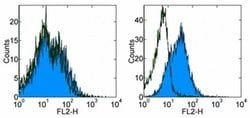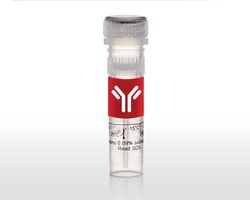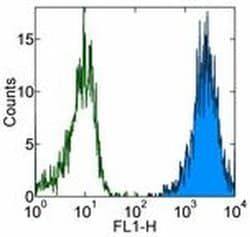50-139-56
CD279 (PD-1) Monoclonal Antibody (RMP1-30), eBioscience™, Invitrogen™
Manufacturer: Fischer Scientific
Select a Size
| Pack Size | SKU | Availability | Price |
|---|---|---|---|
| Each of 1 | 50-139-56-Each-of-1 | In Stock | ₹ 16,821.00 |
50-139-56 - Each of 1
In Stock
Quantity
1
Base Price: ₹ 16,821.00
GST (18%): ₹ 3,027.78
Total Price: ₹ 19,848.78
Antigen
CD279 (PD-1)
Classification
Monoclonal
Concentration
0.5 mg/mL
Formulation
PBS with 0.09% sodium azide; pH 7.2
Gene Accession No.
Q02242
Gene Symbols
Pdcd1
Purification Method
Affinity chromatography
Regulatory Status
RUO
Gene ID (Entrez)
18566
Content And Storage
4° C
Form
Liquid
Applications
Flow Cytometry
Clone
RMP1-30
Conjugate
Unconjugated
Gene
Pdcd1
Gene Alias
CD279; EGK_05005; hPD1; hPD-1; hPD-l; hSLE1; Ly101; mPD-1; PD1; PD-1; Pdc1; Pdcd1; programmed cell death 1; programmed cell death 1 protein; programmed cell death protein 1; programmed cell death protein 1-like; programmed death 1; Protein PD1; protein PD-1; sCD279; SLEB2; soluble CD279; systemic lupus erythematosus susceptibility 2
Host Species
Rat
Quantity
100 μg
Primary or Secondary
Primary
Target Species
Mouse
Product Type
Antibody
Isotype
IgG2b κ
Description
- Description: The RMP1-30 antibody reacts with mouse PD-1 (programmed death-1), a 55 kDa member of the Ig superfamily
- PD-1 contains the immunoreceptor tyrosine-based inhibitory motif (ITIM) and plays a key role in peripheral tolerance and autoimmune disease in mice
- PD-1 is expressed mainly on activated T and B lymphocytes
- Two novel B7 Family members have been identified as PD-1 ligands, PD-L1 (B7-H1) and PD-L2 (B7-DC)
- Evidence reported to date suggests overlapping functions for these ligands and their constitutive expression on some normal tissues and upregulation on activated antigen-presenting cells
- RMP1-30 does not block the binding of either B7-H1-Ig or B7-DC-Ig to PD-1 transfectants
- Applications Reported: The RMP1-30 antibody has been reported for use in flow cytometric analysis
- Applications Tested: The RMP1-30 antibody has been tested by flow cytometric analysis of Con A-stimulated mouse splenocytes
- This can be used at less than or equal to 0.5 μg per test
- A test is defined as the amount (μg) of antibody that will stain a cell sample in a final volume of 100 μL
- Cell number should be determined empirically but can range from 10^5 to 10^8 cells/test
- It is recommended that the antibody be carefully titrated for optimal performance in the assay of interest
- Purity: Greater than 90%, as determined by SDS-PAGE
- Aggregation: Less than 10%, as determined by HPLC
- Filtration: 0.2 μm post-manufacturing filtered
- Cell-mediated immune responses are initiated by T lymphocytes that are themselves stimulated by cognate peptides bound to MHC molecules on antig en-presenting cells (APC)
- T-cell activation is generally self-limited as activated T cells express receptors such as PD-1 (also known as PDCD-1) that mediate inhibitory signals from the APC
- PD-1 can bind two different but related ligands, PDL-1 and PDL-2
- Upon binding to either of these ligands, signals generated by PD-1 inhibit the activation of the immune response in the absence of "edanger signals"e such as LPS or other molecules associated with bacteria or other pathogens
- Evidence for this is seen in PD1-null mice who exhibit hyperactivated immune systems and autoimmune diseases
- Despite its predicted molecular weight, PD-1 often migrates at higher molecular weight in SDS-PAGE.
Compare Similar Items
Show Difference
Antigen: CD279 (PD-1)
Classification: Monoclonal
Concentration: 0.5 mg/mL
Formulation: PBS with 0.09% sodium azide; pH 7.2
Gene Accession No.: Q02242
Gene Symbols: Pdcd1
Purification Method: Affinity chromatography
Regulatory Status: RUO
Gene ID (Entrez): 18566
Content And Storage: 4° C
Form: Liquid
Applications: Flow Cytometry
Clone: RMP1-30
Conjugate: Unconjugated
Gene: Pdcd1
Gene Alias: CD279; EGK_05005; hPD1; hPD-1; hPD-l; hSLE1; Ly101; mPD-1; PD1; PD-1; Pdc1; Pdcd1; programmed cell death 1; programmed cell death 1 protein; programmed cell death protein 1; programmed cell death protein 1-like; programmed death 1; Protein PD1; protein PD-1; sCD279; SLEB2; soluble CD279; systemic lupus erythematosus susceptibility 2
Host Species: Rat
Quantity: 100 μg
Primary or Secondary: Primary
Target Species: Mouse
Product Type: Antibody
Isotype: IgG2b κ
Antigen:
CD279 (PD-1)
Classification:
Monoclonal
Concentration:
0.5 mg/mL
Formulation:
PBS with 0.09% sodium azide; pH 7.2
Gene Accession No.:
Q02242
Gene Symbols:
Pdcd1
Purification Method:
Affinity chromatography
Regulatory Status:
RUO
Gene ID (Entrez):
18566
Content And Storage:
4° C
Form:
Liquid
Applications:
Flow Cytometry
Clone:
RMP1-30
Conjugate:
Unconjugated
Gene:
Pdcd1
Gene Alias:
CD279; EGK_05005; hPD1; hPD-1; hPD-l; hSLE1; Ly101; mPD-1; PD1; PD-1; Pdc1; Pdcd1; programmed cell death 1; programmed cell death 1 protein; programmed cell death protein 1; programmed cell death protein 1-like; programmed death 1; Protein PD1; protein PD-1; sCD279; SLEB2; soluble CD279; systemic lupus erythematosus susceptibility 2
Host Species:
Rat
Quantity:
100 μg
Primary or Secondary:
Primary
Target Species:
Mouse
Product Type:
Antibody
Isotype:
IgG2b κ
Antigen: CD279 (PD-1)
Classification: Monoclonal
Concentration: 0.5 mg/mL
Formulation: PBS with 0.09% sodium azide; pH 7.2
Gene Accession No.: Q02242
Gene Symbols: Pdcd1
Purification Method: Affinity chromatography
Regulatory Status: RUO
Gene ID (Entrez): 18566
Content And Storage: 4° C
Form: Liquid
Applications: Flow Cytometry, Functional Assay
Clone: RMP1-14
Conjugate: Unconjugated
Gene: Pdcd1
Gene Alias: CD279; EGK_05005; hPD1; hPD-1; hPD-l; hSLE1; Ly101; mPD-1; PD1; PD-1; Pdc1; Pdcd1; programmed cell death 1; programmed cell death 1 protein; programmed cell death protein 1; programmed cell death protein 1-like; programmed death 1; Protein PD1; protein PD-1; sCD279; SLEB2; soluble CD279; systemic lupus erythematosus susceptibility 2
Host Species: Rat
Quantity: 100 μg
Primary or Secondary: Primary
Target Species: Mouse
Product Type: Antibody
Isotype: IgG2a κ
Antigen:
CD279 (PD-1)
Classification:
Monoclonal
Concentration:
0.5 mg/mL
Formulation:
PBS with 0.09% sodium azide; pH 7.2
Gene Accession No.:
Q02242
Gene Symbols:
Pdcd1
Purification Method:
Affinity chromatography
Regulatory Status:
RUO
Gene ID (Entrez):
18566
Content And Storage:
4° C
Form:
Liquid
Applications:
Flow Cytometry, Functional Assay
Clone:
RMP1-14
Conjugate:
Unconjugated
Gene:
Pdcd1
Gene Alias:
CD279; EGK_05005; hPD1; hPD-1; hPD-l; hSLE1; Ly101; mPD-1; PD1; PD-1; Pdc1; Pdcd1; programmed cell death 1; programmed cell death 1 protein; programmed cell death protein 1; programmed cell death protein 1-like; programmed death 1; Protein PD1; protein PD-1; sCD279; SLEB2; soluble CD279; systemic lupus erythematosus susceptibility 2
Host Species:
Rat
Quantity:
100 μg
Primary or Secondary:
Primary
Target Species:
Mouse
Product Type:
Antibody
Isotype:
IgG2a κ
Antigen: __
Classification: __
Concentration: __
Formulation: __
Gene Accession No.: __
Gene Symbols: __
Purification Method: __
Regulatory Status: __
Gene ID (Entrez): __
Content And Storage: __
Form: __
Applications: __
Clone: __
Conjugate: __
Gene: __
Gene Alias: __
Host Species: __
Quantity: __
Primary or Secondary: __
Target Species: __
Product Type: __
Isotype: __
Antigen:
__
Classification:
__
Concentration:
__
Formulation:
__
Gene Accession No.:
__
Gene Symbols:
__
Purification Method:
__
Regulatory Status:
__
Gene ID (Entrez):
__
Content And Storage:
__
Form:
__
Applications:
__
Clone:
__
Conjugate:
__
Gene:
__
Gene Alias:
__
Host Species:
__
Quantity:
__
Primary or Secondary:
__
Target Species:
__
Product Type:
__
Isotype:
__
Antigen: HLA-ABC
Classification: Monoclonal
Concentration: 0.5 mg/mL
Formulation: PBS with 0.09% sodium azide; pH 7.2
Gene Accession No.: P01889, P04439, P10321
Gene Symbols: HLA-A, HLA-B, HLA-C
Purification Method: Affinity chromatography
Regulatory Status: RUO
Gene ID (Entrez): 3105, 3106, 3107
Content And Storage: 4° C
Form: Liquid
Applications: Flow Cytometry, Immunohistochemistry (Frozen), Immunoprecipitation
Clone: W6/32
Conjugate: Unconjugated
Gene: HLA-C
Gene Alias: A29 protein; alpha chain of MHC class II; antigen presenting molecule; AS; Aw-33; Aw-74; B-4901; B-5001; Bw-47; Bw-50; class I MHC, HLA-B antigen; D6S204; epididymis secretory protein Li 83; H-2K; H2-K; H-2K(d); HEL-S-83; histocompatibility antigen; HLA A; HLA -B; HLA B-40011; HLA B44; HLA C; HLA class I antigen; HLA class I antigen HLA-B; HLA class I histocompatibility antigen C alpha chain; HLA class I histocompatibility antigen Cw-1 alpha chain; HLA class I histocompatibility antigen, A alpha chain; HLA class I histocompatibility antigen, A-1 alpha chain; HLA class I histocompatibility antigen, A-11 alpha chain-like; HLA class I histocompatibility antigen, A-30 alpha chain; HLA class I histocompatibility antigen, A-33 alpha chain; HLA class I histocompatibility antigen, A-74 alpha chain; HLA class I histocompatibility antigen, B alpha chain; HLA class I histocompatibility antigen, B-47 alpha chain; HLA class I histocompatibility antigen, B-50 alpha chain; HLA class I histocompatibility antigen, B-82 alpha chain; HLA class I histocompatibility antigen, C alpha chain; HLA class I histocompatibility antigen, Cw-1 alpha chain; HLA class I histocompatibility antigen, Cw-15 alpha chain; HLA class I histocompatibility antigen, Cw-18 alpha chain; HLA locus; HLA molecule; HLAA; HLA-A; HLA-A locus alpha 2 domain; HLA-A null; HLA-A11; HLA-A33; HLA-Aw33.1; HLAB; HLA-B; HLA-B 1502; HLA-B alpha chain; HLA-B alpha chain (B*2706); HLA-B alpha chain (B*5002); HLA-B alpha-chain; HLA-B*45ZJ; HLA-B15; HLA-B35; HLA-B35 antigen; HLA-B-3506; HLA-B39; HLA-B-3905; HLA-B49; HLA-B50; HLA-B55; HLA-B-5502; HLA-B-5602; HLA-B59; HLA-B61; HLA-Bw50 antigen; HLAC; HLA-C; HLA-C alpha chain; HLA-C alpha chain (HLA-Cw*15v); HLA-C alpha chain for Cw*18GB; HLA-C alpha-chain; HLA-C antigen; HLA-Cw; HLA-Cw*04GB; HLA-Cw*1702; HLA-Cw*18GB; HLA-Cw-1503; HLA-DQB1; HLA-DRB1; HLA-JY3; HLC-C; Human leukocyte antigen A; Human leukocyte antigen C; human leukocyte antigen-C alpha chain; hypothetical protein; lecocyte antigen B; leucocyte antigen A; Leukocyte Antigen; leukocyte antigen C; leukocyte antigen class I-A; leukocyte antigen class I-B; Leukoocyte Antigen; LOC100515902; LOW QUALITY PROTEIN: HLA class I histocompatibility antigen, A-11 alpha chain-like; lymphocyte antigen; major histocompatability complex B antigen; major histocompatibility antigen HLA-C; major histocompatibility complex, class I, A; major histocompatibility complex, class I, B; major histocompatibility complex, class I, C; MCH class I antigen; MGC184092; MGC7052; MHC; MHC 1; MHC antigen; MHC clas I antigen; MHC Class 1; MHC class 1 antigen; MHC class I; MHC class I alpha chain; MHC class I anitgen; MHC class I anti; MHC Class I antigen; MHC class I antigen A*30; MHC class I antigen A*33; MHC class I antigen A*74; MHC class I antigen B*47; MHC class I antigen B*50; MHC class I antigen B*82; MHC class I antigen Cw*15; MHC class I antigen Cw*18; MHC class I antigen GN00104; MHC class I antigen heavy chain; MHC class I antigen heavy chain HLA-C; MHC class I antigen HLA-A heavy chain; MHC class I antigen HLA-A33; MHC class I antigen HLA-B alpha chain; MHC class I antigen HLA-B heavy chain; MHC class I antigen null protein; MHC class I antigen SHCHA; MHC class I antigene; MHC class I histocompatibility antigen; MHC class I human leukocyte antigen; MHC class I molecule; MHC class I protein; MHC class II antigen; MHC class l antigen; MHC classI antigen; MHC HLA-ABC; MHC HLA-B cell surface glycoprotein; MHC HLA-B transmembrane glycoprotein; MHC HLA-B27d; MHC HLA-B27-HS; MHC HLA-B39N; MHC I HLA; MHC1; PSORS1; SPDA1; surface antigen; truncated class I antigen; truncated MHC class I antigen
Host Species: Mouse
Quantity: 100 μg
Primary or Secondary: Primary
Target Species: Human
Product Type: Antibody
Isotype: IgG2a κ
Antigen:
HLA-ABC
Classification:
Monoclonal
Concentration:
0.5 mg/mL
Formulation:
PBS with 0.09% sodium azide; pH 7.2
Gene Accession No.:
P01889, P04439, P10321
Gene Symbols:
HLA-A, HLA-B, HLA-C
Purification Method:
Affinity chromatography
Regulatory Status:
RUO
Gene ID (Entrez):
3105, 3106, 3107
Content And Storage:
4° C
Form:
Liquid
Applications:
Flow Cytometry, Immunohistochemistry (Frozen), Immunoprecipitation
Clone:
W6/32
Conjugate:
Unconjugated
Gene:
HLA-C
Gene Alias:
A29 protein; alpha chain of MHC class II; antigen presenting molecule; AS; Aw-33; Aw-74; B-4901; B-5001; Bw-47; Bw-50; class I MHC, HLA-B antigen; D6S204; epididymis secretory protein Li 83; H-2K; H2-K; H-2K(d); HEL-S-83; histocompatibility antigen; HLA A; HLA -B; HLA B-40011; HLA B44; HLA C; HLA class I antigen; HLA class I antigen HLA-B; HLA class I histocompatibility antigen C alpha chain; HLA class I histocompatibility antigen Cw-1 alpha chain; HLA class I histocompatibility antigen, A alpha chain; HLA class I histocompatibility antigen, A-1 alpha chain; HLA class I histocompatibility antigen, A-11 alpha chain-like; HLA class I histocompatibility antigen, A-30 alpha chain; HLA class I histocompatibility antigen, A-33 alpha chain; HLA class I histocompatibility antigen, A-74 alpha chain; HLA class I histocompatibility antigen, B alpha chain; HLA class I histocompatibility antigen, B-47 alpha chain; HLA class I histocompatibility antigen, B-50 alpha chain; HLA class I histocompatibility antigen, B-82 alpha chain; HLA class I histocompatibility antigen, C alpha chain; HLA class I histocompatibility antigen, Cw-1 alpha chain; HLA class I histocompatibility antigen, Cw-15 alpha chain; HLA class I histocompatibility antigen, Cw-18 alpha chain; HLA locus; HLA molecule; HLAA; HLA-A; HLA-A locus alpha 2 domain; HLA-A null; HLA-A11; HLA-A33; HLA-Aw33.1; HLAB; HLA-B; HLA-B 1502; HLA-B alpha chain; HLA-B alpha chain (B*2706); HLA-B alpha chain (B*5002); HLA-B alpha-chain; HLA-B*45ZJ; HLA-B15; HLA-B35; HLA-B35 antigen; HLA-B-3506; HLA-B39; HLA-B-3905; HLA-B49; HLA-B50; HLA-B55; HLA-B-5502; HLA-B-5602; HLA-B59; HLA-B61; HLA-Bw50 antigen; HLAC; HLA-C; HLA-C alpha chain; HLA-C alpha chain (HLA-Cw*15v); HLA-C alpha chain for Cw*18GB; HLA-C alpha-chain; HLA-C antigen; HLA-Cw; HLA-Cw*04GB; HLA-Cw*1702; HLA-Cw*18GB; HLA-Cw-1503; HLA-DQB1; HLA-DRB1; HLA-JY3; HLC-C; Human leukocyte antigen A; Human leukocyte antigen C; human leukocyte antigen-C alpha chain; hypothetical protein; lecocyte antigen B; leucocyte antigen A; Leukocyte Antigen; leukocyte antigen C; leukocyte antigen class I-A; leukocyte antigen class I-B; Leukoocyte Antigen; LOC100515902; LOW QUALITY PROTEIN: HLA class I histocompatibility antigen, A-11 alpha chain-like; lymphocyte antigen; major histocompatability complex B antigen; major histocompatibility antigen HLA-C; major histocompatibility complex, class I, A; major histocompatibility complex, class I, B; major histocompatibility complex, class I, C; MCH class I antigen; MGC184092; MGC7052; MHC; MHC 1; MHC antigen; MHC clas I antigen; MHC Class 1; MHC class 1 antigen; MHC class I; MHC class I alpha chain; MHC class I anitgen; MHC class I anti; MHC Class I antigen; MHC class I antigen A*30; MHC class I antigen A*33; MHC class I antigen A*74; MHC class I antigen B*47; MHC class I antigen B*50; MHC class I antigen B*82; MHC class I antigen Cw*15; MHC class I antigen Cw*18; MHC class I antigen GN00104; MHC class I antigen heavy chain; MHC class I antigen heavy chain HLA-C; MHC class I antigen HLA-A heavy chain; MHC class I antigen HLA-A33; MHC class I antigen HLA-B alpha chain; MHC class I antigen HLA-B heavy chain; MHC class I antigen null protein; MHC class I antigen SHCHA; MHC class I antigene; MHC class I histocompatibility antigen; MHC class I human leukocyte antigen; MHC class I molecule; MHC class I protein; MHC class II antigen; MHC class l antigen; MHC classI antigen; MHC HLA-ABC; MHC HLA-B cell surface glycoprotein; MHC HLA-B transmembrane glycoprotein; MHC HLA-B27d; MHC HLA-B27-HS; MHC HLA-B39N; MHC I HLA; MHC1; PSORS1; SPDA1; surface antigen; truncated class I antigen; truncated MHC class I antigen
Host Species:
Mouse
Quantity:
100 μg
Primary or Secondary:
Primary
Target Species:
Human
Product Type:
Antibody
Isotype:
IgG2a κ



